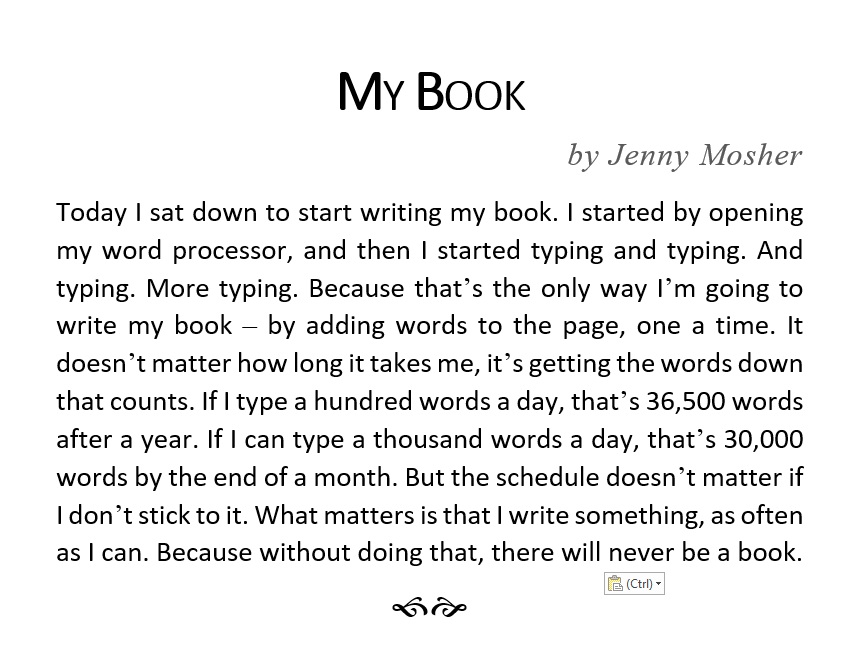I meet a great variety of people in my business, but the ones who entertain me the most are those who say, ‘I want to write a book.’ My question is always, ‘What’s stopping you?’ The myriad of answers (excuses?) is always interesting (and, I have to admit, sometimes perversely entertaining), but the bottom line is that, for many of these people, they don’t really want to write a book, they want the book to write itself. They want to see a book with their name on it, but they don’t want to do the hard yakka to make it happen.
Well, sorry folks, books don’t write themselves. But if you do want to write a book and need a guide to get it done, here’s my author’s hack on how to write a book in eleven easy steps:
-
Think of an idea. Could be a story you’ve made up (fiction), or something real that you want to share with the world (non-fiction).
-
Start writing. Truly. You would be astounded to know how many people can’t even tick this step off their lists.
-
Keep writing until you can’t write any more. Keep writing until the book feels finished, until you’ve got nothing left to say on the topic. Don’t stop to edit. Just keep writing. Like this. One sentence after another. If you need to work out how to kill off Brad so that Janet’s left alone in the big, creepy mansion, type such a line in big red letters: ‘Work out how to kill off Brad so that Janet’s left alone in the big, creepy mansion’ and come back to it later.
-
When you feel that you’ve finished writing, revise, starting with working out how to kill off Brad so that Janet’s left alone in the big, creepy mansion, and the other big red issues that you’ve highlighted.
-
Revise, revise, revise.
-
Send out to beta readers. Choose a variety – people who are likely to be supportive as well as people you know will be happy to criticise you. You need to know what’s going to work and what’s not going to work for the Average Joe Reader. And ironically, it won’t be the same from one Average Joe Reader to the next.
-
Face the feedback. If you can’t cope with people you know making suggestions, then you’ll never handle honest reviews from total strangers!
-
Revise, revise, revise. You don’t have to take onboard everything your beta readers said, but you should at least consider the points they make. Then toss out what won’t work for you and adopt what sits comfortably and is in line with the sort of book you’re trying to produce.
-
Consult an editor. Yes, seriously. Even if you were an A grade English student in high school, consult an editor. You will be shocked to find out what you don’t know.
-
Revise.
-
Seek self publishing options. Seriously. Self publishing. If this is your first book and you’re not a celebrity chef, then you’re highly unlikely to get a publishing contract, even if Janet does escape the mansion in the most spectacular way possible thus creating the best potential movie premise ever. So don’t waste your time. And even if you’ve had five books published, even ‘traditionally published’ authors are now jumping ship and self publishing. There’s no shame in it. It is the 21st century after all.
So, follow the above steps and – voila! – you’ll have your book. Simple as, hey?
Happy writing!
Find an editor:
Editors in Australia:
IndieMosh experts: http://indiemosh.com.au/find-an-expert
IPEd: http://iped-editors.org/
Editors in the UK:
SfEP: http://www.sfep.org.uk/
Editors in the US:
ACES: http://www.copydesk.org/
Self publishing in Australia (also known as ‘shameless self promotion’):
IndieMosh: http://indiemosh.com.au/
Self publishing for Australian authors: https://jennifermosher.com.au/products/books/


So true! And following step#2 can take one anywhere! I wrote 787K+ words for 10 stories by starting with one simple idea and following my character through his/her textual life – the travel, meetings, loves and dislikes each led to another path and so on untilmy character’s story ran down. Even then, there were openings for another path that had opened up during this part of their lives…
You’re not wrong, John, although I think step 2 is the hardest for some people to follow. The writer’s block seems to start long before the writing does!